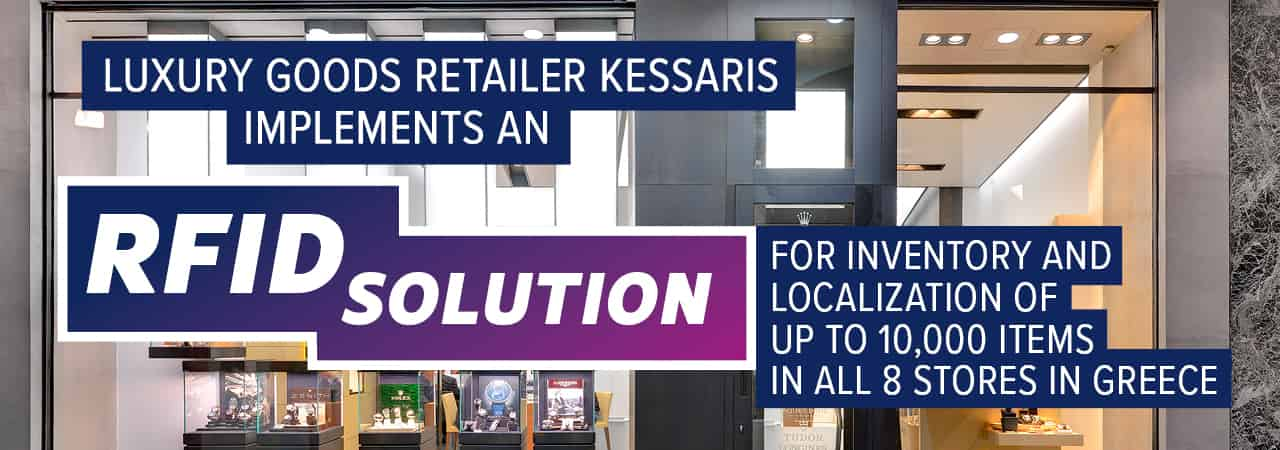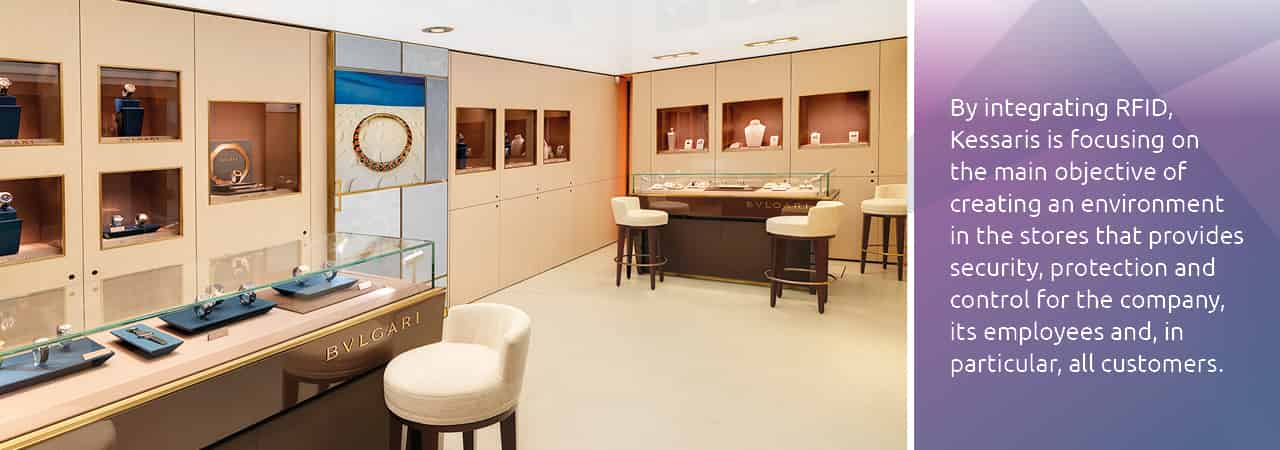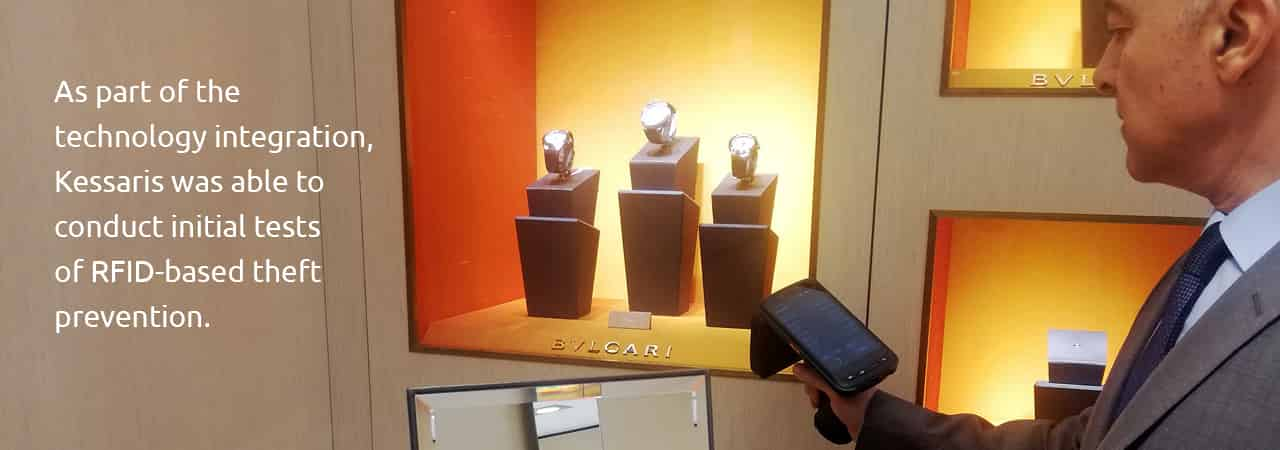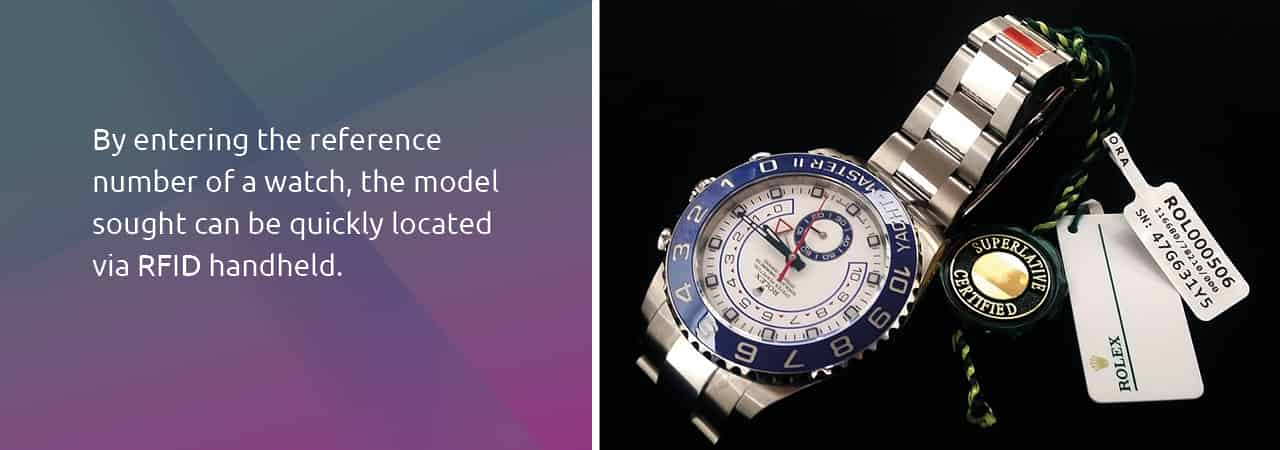Luxury Goods Retailer Kessaris implements an RFID solution for Inventory and Localization of up to 10,000 items
Luxury goods retailer Kessaris offers around 10,000 different jewelry and luxury items in each of its eight stores – with prices of 5,000 euros or more not being a rarity among them. The main objective for a technologybased optimization is the creation of an environment which inspires security, safety and control for the company, the staff and the clients.
For Kessaris, the integration of a technological solution was indispensable in order to carry out regular inventories with the highest possible accuracy.
The particular challenge here was that conventional tagging and article surveillance solutions were ruled out for aesthetic reasons, as they would have made the fitting more complicated. With a UHF RFIDbased solution, Kessaris was able to achieve initial success in the area of watch identification. In the subsequent development steps, the luxury goods retailer is focusing on the areas of jewelry and decorative labeling.
Vassilis Kessaris, Managing Director & Co-Owner, Kessaris, in an interview with RFID & Wireless IoT Global.
Discreet labeling of luxury goods
The Greek luxury goods retailer Kessaris offers high-priced watches and luxury items from the jewelry segment in eight branches in the cities of Athens, Messinia, Marousi and Mykonos. Vassilis Kessaris, second-generation managing director as well as co-owner of the chain, which was founded in 1965 and has over 40 employees, recognized that the documentation of the inventory and the detailed status quo of the approximately 10,000 individual articles per store is crucial for security. Manual checks were time-consuming and prone to errors.
However, the small size of the inventory such as watches, rings and chains did not allow the use of standard solutions. Another process requirement was that the merchandise identification should be as discreet as possible. Together with RFID systems integrator Trinity Systems, Kessaris is developing specific UHF RFID identification solutions for the jewelry sector. "We are doing pioneering work because there is no corresponding solution for the jewelry trade. An out-of-the-box application was not available," says Vassilis Kessaris, underlining the importance of the development work.
Eight shops full of luxury goods
Kessaris has a total of eight stores in Greece. Three of these stores are only open seasonally. Four boutiques are located in the center of Athens, two in Mykonos, one in Messinia and another in Marousi. Each store has an average of around 10,000 articles in stock and on display. Kessaris offers an extensive selection of luxury goods: watches, jewelry and luxury gifts such as stationery, precious metal articles, decorative products and cuff links.
The development of solutions continues
In 2017, Kessaris began researching a solution tailored to jeweler-specific needs. At the beginning of 2018, the cooperation with a Greek RFID systems integrator began in order to implement the appropriate hardware and software. Tests to define the suitable tags took about three months. It also took almost four months to define the suitable coding of the tags so that the inscribed information would match the reference numbers of the individual watch brands, for example. The first rollout in the watch sector started in 2019.
Vassilis Kessaris expects full tagging to be possible by mid- 2020 with the completion of all development work and tests.
Inventory accuracy increased, time saved
The RFID-based automation of the inventory process generates three advantages on different levels. The first advantage is that scanning RFID labels eliminates human error.
The second advantage lies in time saving, as brand owner and co-founder Vassilis Kessaris comments: "Trying to locate and check all items by hand is quite tedious and takes a lot of time. Our application started with watches. Within the boutique, the watches are usually located in three different places. If we wanted to do an inventory control for a particular brand, we would have to cover all three locations at the same time to find all the items. With the RFID scanner, only one employee is needed to scan all items at all three locations.” This also reduces the effort required for inventory, which is the third benefit.
Technology
The search for suitable tags continues
UHF RFID labels are used for the identification of products. At the moment, appropriate tags have not been identified for any and all products. All tags are coded and printed with an RFID printer in the main store. UHF RFID handhelds are used for recording and localization in the stores. Kessaris uses jeweler- specific software to process the data captured.
Tracking Software for Jewelers
The RFID systems integrator Trinity Systems is responsible for the complete solution. The basis is the "JewelTrack" software developed by Trinity Systems, which is adapted to the special requirements of the watch and jewelry sector. The tags are encoded in accordance with EPC Gen2 ISO/IEC 18000-6 as the standard, taking into account the fact that, for example, luxury watch manufacturers rely on reference numbers instead of serialization. In this way, brand-specific inventory is also possible across branches. Kessaris uses a printer model from Zebra Technologies.
Watches 100 percent tagged
Kessaris is starting the RFID test phase together with Trinity Systems in the watch sector. Here, the rollout has been entirely completed. After delivery to the central branch, all watches are marked with a small UHF RFID label and initially recorded in JewelTrack. From the main boutique, the watches are distributed to the other seven stores. Inventories of the watch stock are carried out by employees on average once a month.
Additionally, random partial stocktaking and situational localizations are carried out to find a specific watch in one of the three areas between the counter, showcases or safe. The procedure for regular physical inventory is brand-specific. Stocktaking with a UHF RFID handheld delivers results of 95 to 97 percent accuracy on average. In the case of random sample inventories, the accuracy is 95 to 100 percent. Not every store has its own handheld. If physical inventories are due, the work is carried out by one employee in several stores one after the other.
Technological challenges to be solved
Kessaris has identified the requirements for size and maximum readability as the main challenge. "The smaller the tags used, the worse the reading results. The metallic environment makes things even more difficult. We are also confronted with the fact that the label quality is not always 100 percent and that on a roll with 250 tags there are sometimes failures of two to five percent. This fact leads to inaccuracies. If, for example, a watch is not found due to a defective tag, we are talking about an item worth several thousand euros. Printability is also limited due to the small maximum size of the labels," reports Vassilis Kessaris.
A second challenge still to be solved is the tagging of items outside the watch and jewelry sector. "At the moment, the complete tagging of the product group comprised of stationery and decorative precious metal articles has not yet been solved. Interference caused by the metallic objects cannot yet be sufficiently avoided. Inaccurate reading results are the consequence. Therefore, the test and development phase continues together with Trinity Systems".
Strategy
The Roadmap has no end date (yet)
With the complete rollout in the watch sector, Kessaris has already taken a decisive step towards automated inventory control. The chosen technology works. This step is to be followed by others in order to achieve the goal of 100% inventory via RFID.
Vassilis Kessaris is aware that this process will take time: "We have been able to achieve good results and significant efficiency gains, especially in the area of watch inventory. The implementation in the other areas - jewelry as well as stationery and decorative items - will still take time. We have to wait until the appropriate tags are developed. Therefore, we have not set a specific date when the RFID implementation will need to be adapted. Since, according to our research, there is no comparable solution so far, we have to obtain all the necessary know-how ourselves. As long as it is not possible to label all articles 100 percent in the shops, Kessaris will refrain from integrating stationary reading technology, for example in the checkout counter. A fixed reading infrastructure does not make sense at the moment. We will only discuss further steps in the automation of inventory management processes when the appropriate tags with the appropriate quality are ready for use."
Anti-theft protection would be top-notch
As part of the technology integration, Kessaris was able to conduct initial tests of RFID-based theft prevention - with insufficient results, as Vassilis Kessaris reports:
"An initial experiment has been conducted, but the results are not nearly satisfactory at the moment. Extensive development work must be done in this area. The type of antenna placement and alignment as well as the tuning of the ranges are complex processes. One of the next phases will be to install another anti-theft pilot in one of the boutiques. If the results are satisfactory, we will adopt the solution as a template in the other boutiques. This would be the top-notch solution: to solve inventory management and theft protection with one technology. A lot depends on the tag development. We would be thrilled if tag developers paid more attention to the tagging of jewelry and watches – because the need for tagging luxury goods is real worldwide, but there is still a long way to go.”
Kessaris
Kessaris was founded in 1965 by Costas Kessaris and is a company which sells luxury watches of the brands Rolex, Bvlgari, Panerai or IWC, among others, at eight locations in Greece. With its own design and workshop, the company produces individual pieces of jewelry and sells high-quality stationery, decorative items and gift articles.
Vassilis Kessaris is managing director of the Greek jewelry chain Kessaris. After his studies in New Jersey, he returned to Greece and became co-owner of the jewelry chain in 1985, together with his father Costas Kessaris.







